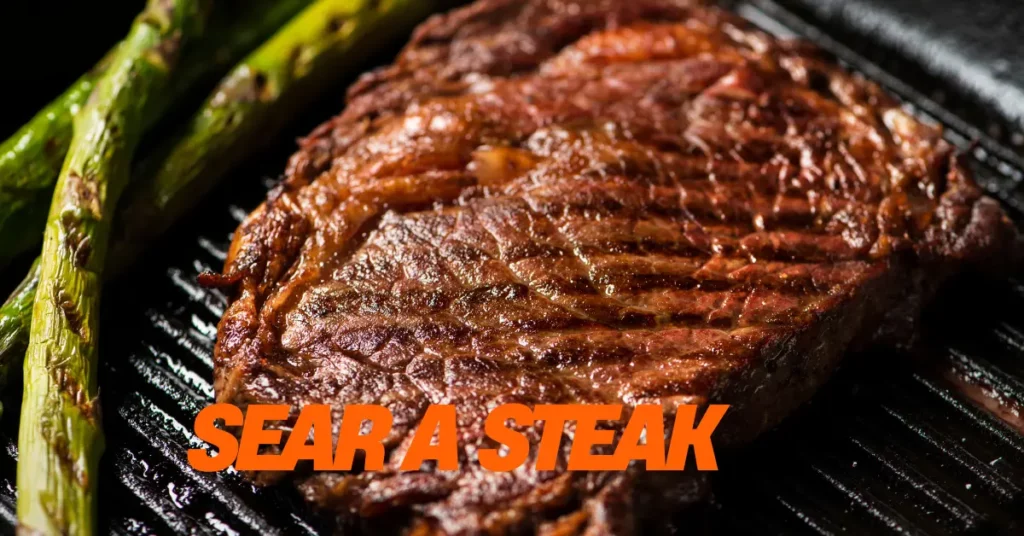This post may contain affiliate links. If you use these links to buy something we may earn a small commission. Thanks.
If you’ve ever watched a chef cook a steak, you’ve probably seen them talk about the importance of getting a perfect sear. But what does it really mean to sear a steak? Searing is a cooking technique that involves exposing the surface of the meat to high heat, creating a flavorful brown crust while locking in juices. This process enhances both taste and texture, making the steak more enjoyable to eat. In this guide, we’ll break down everything you need to know about searing, from the science behind it to step-by-step techniques and common mistakes to avoid.
The Science Behind Searing
Searing isn’t just about making your steak look good it’s a scientific process that improves flavor and texture. The two main reactions responsible for this transformation are the Maillard reaction and caramelization.
1. The Maillard Reaction
This chemical reaction occurs when proteins and sugars in the meat interact under high heat, forming complex flavors and a crispy crust. The Maillard reaction is responsible for the deep, rich taste of a perfectly seared steak. This reaction starts occurring around 300°F to 350°F (150°C to 175°C), which is why it’s crucial to use high heat for searing.
2. Caramelization
Caramelization happens when the natural sugars in the meat break down under heat, creating a slightly sweet, nutty flavor. While less significant than the Maillard reaction in steaks (since meat is not naturally high in sugar), it still plays a small role in enhancing the overall taste.

Steps to Properly Sear a Steak
To achieve the perfect sear, follow these essential steps:
1. Choosing the Right Steak
Not all steaks are ideal for searing. Look for cuts that are at least 1 to 1.5 inches thick to ensure a good crust without overcooking the inside. The best cuts for searing include:
- Ribeye
- New York Strip
- Filet Mignon
- Porterhouse
- T-bone
2. Preparing the Steak
- Bring the steak to room temperature: Take the steak out of the fridge at least 30-45 minutes before cooking. A cold steak won’t sear properly and will cook unevenly.
- Pat dry: Moisture is the enemy of a good sear. Use a paper towel to remove excess moisture from the surface.
- Season generously: Use kosher salt and black pepper to enhance the flavor. For additional taste, add garlic powder, smoked paprika, or fresh herbs.
3. Choosing the Right Pan
A cast iron skillet is the best choice for searing because it retains and distributes heat evenly. However, a stainless steel pan can also work well. Avoid nonstick pans, as they don’t handle high heat effectively.
4. Preheating the Pan
Heat your pan over high heat for at least 5 minutes before adding oil. The pan should be extremely hot—hot enough that a drop of water sizzles and evaporates instantly upon contact.
5. Using the Right Oil
Since searing requires high temperatures, use oils with a high smoke point, such as:
- Avocado oil
- Canola oil
- Grapeseed oil
- Peanut oil
Avoid butter at this stage, as it burns quickly due to its low smoke point.
6. Placing the Steak in the Pan
Once the oil is shimmering and just starting to smoke, carefully place the steak in the pan. Do not move it for at least 2-3 minutes—this allows a proper crust to form.
7. Flipping and Timing
Flip the steak only once, after 2-3 minutes on each side. Use tongs, not a fork, to avoid piercing the meat and losing juices.
8. Adding Butter and Aromatics (Optional)
Once the steak has been flipped, add a tablespoon of butter, along with garlic cloves, rosemary, or thyme. Baste the steak by tilting the pan and spooning the melted butter over the top.
9. Letting the Steak Rest
After searing, transfer the steak to a cutting board and let it rest for 5-10 minutes. This allows the juices to redistribute, keeping the steak juicy and tender.
Common Mistakes to Avoid
Even experienced cooks sometimes make mistakes when searing a steak. Avoid these common pitfalls:
- Using a cold pan: If the pan isn’t hot enough, the steak won’t develop a proper crust.
- Moving the steak too soon: Let the steak sit undisturbed for at least 2-3 minutes per side to form a crust.
- Overcrowding the pan: Too many steaks in one pan lower the heat and create steam, preventing a proper sear.
- Not resting the steak: Cutting into the steak too soon releases the juices, making the meat dry.
Benefits of Searing a Steak
Searing does more than just make the steak look good—it significantly enhances the overall dining experience. Here’s why it’s essential:
- Enhances flavor: The Maillard reaction produces complex, rich flavors that can’t be achieved through other cooking methods.
- Creates a crispy crust: A well-seared steak has a satisfying contrast between the crunchy exterior and tender interior.
- Locks in juices: Searing helps retain moisture, making the steak juicier and more flavorful.
Alternative Methods for Searing
There are multiple ways to sear a steak, depending on your cooking preference:
1. Reverse Sear Method
This method involves slow-cooking the steak in an oven at 225°F (107°C) until it reaches about 10-15°F below the target doneness, then searing it in a hot pan for 1-2 minutes per side.
2. Searing on a Grill vs. Stovetop
- Grill: Direct high heat on a gas or charcoal grill can create a fantastic sear.
- Stovetop: Allows more control over heat and the ability to baste with butter and aromatics.
3. Using a Blowtorch for Precision
For an ultra-crispy crust, some chefs use a culinary blowtorch after cooking the steak sous vide. This method allows for precise control over browning without overcooking the inside.
Conclusion
Searing a steak is a fundamental technique that every home cook and grill enthusiast should master. By following the proper steps—choosing the right steak, using high heat, and allowing the Maillard reaction to work its magic—you can achieve a steakhouse-quality crust at home. Whether you prefer a traditional pan sear, a reverse sear, or even an open-flame grilling method, understanding the science and best practices of searing will elevate your cooking skills. Now, grab your favorite cut, heat up that skillet, and start searing.
